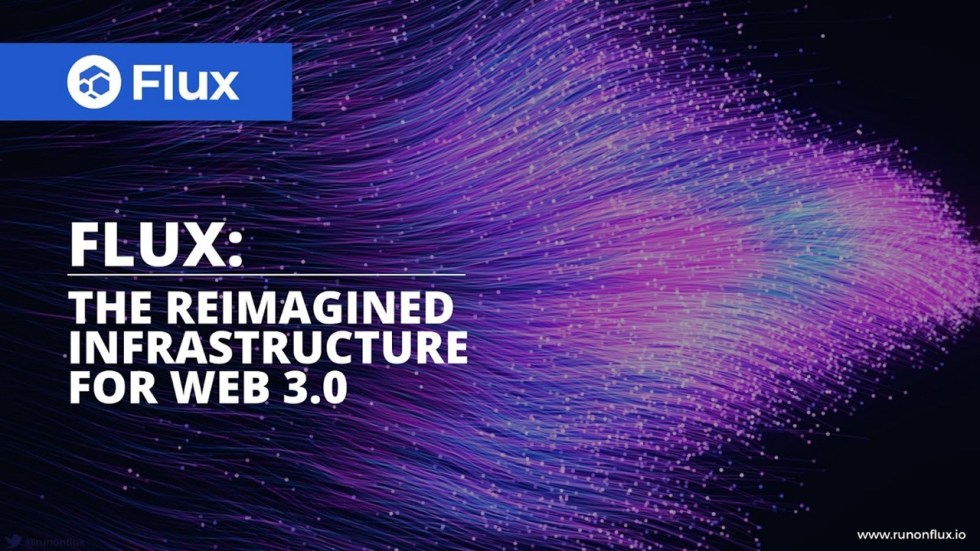Launched on January 31st, 2018, the Flux Ecosystem was designed to provide blockchain-based solutions and decentralized computing services supported by a one a kind development environment, thus providing a strong alternative to similar centralized services such as Amazon Web Services (AWS).
The ecosystem is composed of its own native token, called Flux, that operates with a Proof-of-Work consensus algorithm, a decentralized computational network currently consisting of about 2300 Flux Nodes, its own Linux-based operating system (FluxOS), and its own blockchain application suite and self-custodial wallet called Zelcore.
Flux was designed to provide developers and users with a decentralized and easy-to-use platform that will enable them to build and deploy decentralized applications (dApps) on the Internet of the future, Web 3.0. The Flux economic model incentivizes network participation to enable network growth, while also deterring bad actors from attacking it through locking of node collaterals.
In addition, the FLUX cryptocurrency is easier to mine than some others, such as Bitcoin and Ethereum as it only requires 3 gigabytes of GPU RAM. This fair-mined system via GPU is complemented by the team’s commitment to maintaining the network ASIC resistant. Thus, big mining operations will be unable to price out smaller miners from the network which benefits from more decentralization.
To fulfill the vision of a decentralized future, the team behind Flux has provided the community with the necessary tools to participate in the decisions that will affect the entire ecosystem through xDAO governance. Flux is community-driven and open-source and doesn’t answer to legacy financial institutions, big tech companies or venture capital investors.
According to an official post published by the team behind the project, the community is one of the factors that set the Flux ecosystem apart from other initiatives in the crypto industry:
Flux is nothing without people like its GPU miners, node operators, and community contributors and this is reflected in its economic model where Flux holders, miners, and node operators are highly incentivized.
Why Flux Is The Best Bet For A Decentralized Future
Although the crypto industry has grown above the trillion-dollar market value, thousands of projects lack a truly innovative model with no prospect of offering solutions for real problems. Many cryptocurrency projects are simply copies of more successful platforms. In the long run, this can hurt the rate of crypto adoption through a lack of innovation and neglect of the original vision of decentralization pioneered by Bitcoin founder Satoshi Nakamoto.
The Flux ecosystem provides critical infrastructure and the tools necessary to deploy solutions that will onboard millions of users, truly improve blockchain technology and positively impact adoption by traditional industries. The many resources and use-cases offered by the Flux ecosystem are a catalyst for the network’s value proposition and for increased demand of its native asset, FLUX.
As adoption increases, many more will be incentivized to participate in the ecosystem and take part in its reward structure. GPU miners, node operators and Flux holders are incentivized through block rewards, parallel mining rewards and airdrops. Developers are incentivized to develop on Flux through very aggressive pricing of Flux network services.
Developers can create their apps with the network frictionless and interoperable environment, according to the project’s Whitepaper:
This ease-of-use approach will greatly assist quick deployment of sidechains, asset layers, 3rd party apps, smart contracts, basically anything that can be built into a container.
The Flux Ecosystem And Its Vision Of The Future
The Flux Network and its ecosystem have seen constant development since its deployment in 2018. The team behind the project and the Flux community has focused on building a working product all throughout the bear market, rather than marketing an unfinished one. The Flux ecosystem is live and operational, the project is open-source and fully transparent and there are development updates weekly. The project has a well-designed roadmap that has seen the consolidation of major milestones.
In Q4, 2021, the project is deploying major upgrades to FluxOS, enabling UDP and multi-container support making it possible to host more complex applications, also node deployment and management have been made simpler and the Flux parallel assets on the Solana and Tron blockchains is set to deploy in December. Thus, users will be able to benefit from the network’s increase in interoperability and from its unique trading opportunities as the Fusion cross-chain bridge will then support 5 out of the 10 planned blockchains.
In addition, the network has deployed more dApps, and has committed to deploy an additional 30 dApps during December in the so-called ’30-in-30’ event.
2022 is set to be yet another exciting year for Flux as it prepares to introduce new parallels assets, AVAX, ADA, ATOM and Matic are currently in review for possible deployment. The platform will also launch an NFT feature in 2022 to offer its users access to one of the hottest trends in the crypto space, amongst many more milestones that will continue to make the Flux ecosystem one of the fastest and most innovative platforms in the crypto industry.
